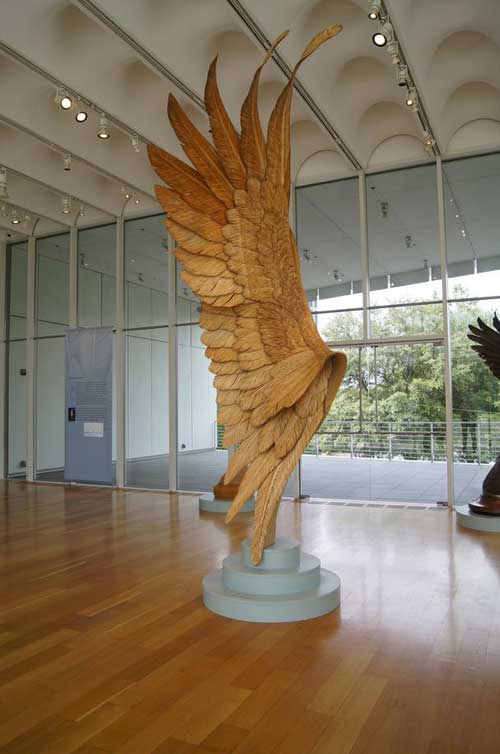
 Sculpture News at SculptSite.com
Sculpture News at SculptSite.com
Grainger McKoy Sculpture |
| Access Atlanta By Howard Pousner The Atlanta Journal-Constitution McKoy's artful sculpture takes wing at High MuseumThe birds in "The Sculpture of Grainger McKoy," opening at the High Museum of Art on Sunday, are so lifelike that it's hard to believe that most are little more than artfully carved basswood and oil paint, connected by completely disguised metal. A crafty departure for the High, the wildlife art exhibit features 34 sculptures of varying sizes, models, sketches and a film of the artist at work in his Sumter, S.C., studio. The hand-carved sculptures range from his first piece, a simple cypress shorebird that McKoy created at age 13 in 1960, to evocative, sophisticated groupings that reflect his early interest and studies in architecture. We asked the artist to share the back-story on three: "Recovery Stroke" (2008) McKoy, 64, has created several versions of this highly symbolic depiction of a bird's wing, in different scales and materials (basswood, silver, bronze), since 1999. "Every bird has a power stroke, a recovery stroke, a power stroke, a recovery stroke ..." he said. "And over the years of carving birds in flight, I've discovered that the recovery stroke has a certain grace and beauty that the power stroke doesn't have. Yet it's the weakest wing position that a bird can be in, the most vulnerable." McKoy found inspiration for the series from a passage in Second Corinthians: "My grace is sufficient for you, for my power is made perfect in weakness." The Hollings Cancer Center commissioned him to create a monumental version to display inside its Charleston facility. "Everybody in a cancer center is in recovery," McKoy said. "But if you think about it, everybody is in recovery somewhere in their lives -- economically, physically, spiritually, you name it." After producing the work for the Cancer Center, he was commissioned again to create the centerpiece sculpture for the Swan Lake Iris Gardens in his hometown of Sumter. This eye-catching 12-foot-high basswood model, carved in 2008, is a study for that stainless steel piece. "Sanderlings" (1986) McKoy is captivated by the flashing of flocks of these shorebirds in flight against the dark horizon. "All of the sudden you'll see white and then it'll go dark and back to white," he said. "Somehow they know how to turn at the same time. How they know that, I don't know." In positioning this grouping of 15, he wanted the birds to appear a little off balance, starting with the craning, wave-evoking walnut base that elevates the sculpture. "It adds to the tension of flight, of being airy. Flight seems to be a little off balance, especially when it's still and not moving. That's part of the puzzle." Yet, he pointed out, the sanderlings all appear to be aiming at the same exact distant point, a flock in harmonic convergence. "Carolina Parakeets" (1992) Extinct since the early 20th century, these colorful Southeastern birds, which despite the name are parrots, lived in old forests and rivers from the Ohio Valley to the Gulf of Mexico. They were victims of a diminishing habitat and of farmers who considered them orchard-raiding pests. They also exhibited a self-endangering behavior that led the flock to return immediately to a location where a member had just been killed, leading to even more being shot. "When I was thinking about sculpting this piece, I was reading the journal of Alexander Wilson, an old-time ornithologist before Audubon," McKoy recalled. "He was up on the Ohio River and in a blinding snowstorm, he observed these Carolina parakeets flying down the river 'like pigeons in full cry.' And that image stuck to me." To prepare, he photographed and measured Carolina parakeet specimens in the collection of the Charleston Museum. As a model, McKoy purchased a "cousin," a conure, at a pet shop. "The good thing about an extinct bird is nobody can tell you you're wrong," he said with a twinkle of his striking blue-gray eyes. Exhibit preview "The Sculpture of Grainger McKoy" Opens Sunday through Jan. 8. 10 a.m.-5 p.m. Tuesdays-Saturdays; until 8 p.m. Thursdays; noon-5 p.m. Sundays. $18; $15, students and seniors; $11, ages 6-17; free, children 5 and younger and members. High Museum of Art, 1280 Peachtree St. N.E., Atlanta. 404-733-4444, www.high.org. |
 Grainger McKoy, an accomplished sculptor of birds. When I say accomplished, I mean accomplished. The man is an excellent carver with a knowledge of Ornithology that seems to push the boundaries. You put the aforementioned together with his creativity and you have "The Sculpture of Grainger McKoy". Try not to miss this exhibition. Very nice article by Howard Pousner The Atlanta Journal-Constitution! |
 "Recovery Stroke" by Grainger McKoy |
More Sculpture News ....
Submit your SCULPTURE NEWS.
It's easy, just send us an e-mail
(click on Submit News in the left menu) with your pertinent information along with images, we'll take care of the rest. Sculpture makes our world a much better place in so many ways!
SculptSite.com, along with Sculptors and their creative genius all helping to bring the beauty and message of Sculpture to a hurried world.

